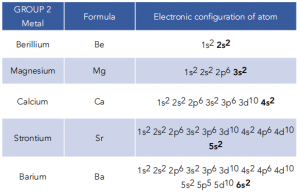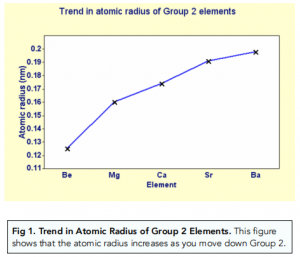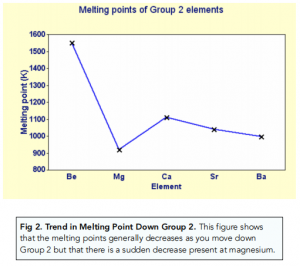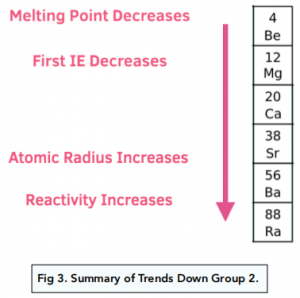Group 2, The Alkaline Earth Metals (A-Level Chemistry)
Group 2, The Alkaline Earth Metals
Introduction to Group 2 Elements

Group 2 elements are collectively known as the Alkaline Earth Metals. The outer shell of group 2 elements contains two electrons and is therefore represented by the sub shell s2. Elements in group 2 will lose two electrons to gain a full outer shell of electrons, to form ions with a +2 charge when they react.
Trends in Group 2 Elements
Atomic Radius Trend Down Group 2
- As you move down Group 2, the atomic radius of the elements increases. The atomic radius of Group 2 elements increases because more and more electron shells are being added down the group.

Melting Point Trend Down Group 2
- As you move down Group 2, the melting points of the elements decreases. Group 2 elements generally have metallic bonding as they are metallic structures. As you move down the group, the radius of the metal ions increases but the number of delocalised electrons stays the same per atom. The charge of +2 of of the positive ions does not change either. Less energy is needed to break the metallic bonds as the delocalised electrons are further away from the positive nuclei because of an increased ionic radius, therefore there is a decreased attraction between them.
- The arrangement of the Group 2 ions in the metal affects the melting point. Between beryllium and radium, there is a change in the melting point trend at magnesium as it has a different crystalline structure.

First Ionisation Energy Trend Down Group 2
- As you move down Group 2, the first ionisation energy of the elements decreases. More electron shells are added as you move down Group 2 which means the atomic radius increases and therefore the outermost shell becomes further and further away from the positive nucleus. The shielding effect on the outermost electrons also increases due to the presence of more inner electron shells containing electrons. The attraction between the outermost electrons and the nucleus decreases, therefore less energy is required to remove them.
Reactivity Trend Down Group 2
- As you move down Group 2, the reactivity of the elements increases. Reactions of Group 2 elements consist of the elements losing electrons to form ions with a +2 charge. As the first ionisation energy decreases as you move down the group, less energy is required to move the electrons, therefore the elements become more reactive.

The alkaline earth metals are a group of elements in the periodic table that include beryllium, magnesium, calcium, strontium, barium, and radium. They are characterized by having similar physical and chemical properties, such as a shiny appearance, high reactivity, and the ability to form compounds with a +2 charge.
Alkali metals and alkaline earth metals are both groups of elements in the periodic table. Alkali metals are located in Group 1 of the periodic table and include elements such as lithium, sodium, and potassium. Alkaline earth metals are located in Group 2 of the periodic table and include elements such as magnesium, calcium, and barium.
Alkaline earth metals are important because they are key components in many industrial and consumer products, such as fertilizers, antacids, and batteries. They are also important in the human body, with calcium playing a key role in bone structure and magnesium being important for nerve and muscle function.
Alkaline earth metals are highly reactive and readily form compounds with other elements. They are reactive with air, water, and many other substances, and are prone to oxidation.
Alkaline earth metals form compounds by losing two electrons to form a +2 charged ion. This allows them to bond with other elements and form compounds with a wide range of properties and applications.
Common uses of alkaline earth metals include fertilizers, antacids, batteries, and alloys. Calcium is also used in the production of cement, while magnesium is used in the production of magnesium alloys.
The study of alkaline earth metals is relevant to A-Level Chemistry because it provides an understanding of the properties and reactivity of this group of elements. This knowledge is important for understanding chemical reactions, chemical bonding, and the properties of different types of materials. Additionally, understanding the properties and uses of alkaline earth metals can be useful for exploring real-world applications of chemistry.






Still got a question? Leave a comment
Leave a comment